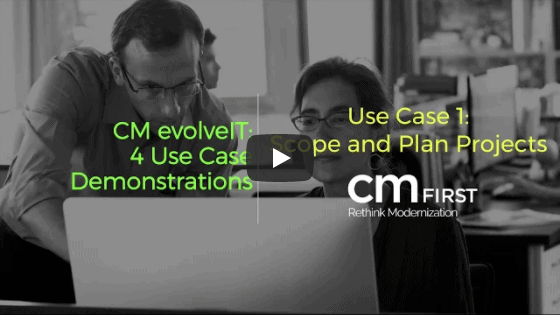Company to demonstrate automated static code analysis management dashboard and industry-first mainframe data lineage and security solution. LAS VEGAS, Nevada – November 14, 2017 – CM First Group will showcase two new offerings at the CA World ‘17 Expo this week: A Code Structure Dashboard extends the power of CM evolveIT to provide management visibility
Apply CM evolveIT’s unique automated static analysis and code slicing technology to four common code analysis use cases.
One of the biggest concerns about maintaining mainframe legacy code is that new developers, and even many of the older ones, don’t really understand what the code is doing for the business on a detailed level. Even if documentation exists, it isn’t enough to ensure that changes to the code won’t eliminate an important feature,
Ever since computers first became integral to the business, the next big challenge emerged: communication between IT and the business. IT-business alignment is a critical exercise if you want to deliver on the business requirements, foster revenue growth and maintain a competitive edge. But this alignment is also critical when you are modernizing or simply
As companies plan modernization projects, the question inevitably arises: what is the best way to modernize a codebase? To ensure that the business is not negatively impacted when modernizing, it is necessary to understand, document, and import all business rules to the new system. As the changes made are meant to improve the business and
Many companies are beginning to realize that the rate of mainframer retirement is only increasing with few new experts in the pipeline. While jobs are plentiful, many members of the workforce do not know COBOL or other legacy languages. They are simply not being taught any longer. And yet, legacy languages are the heart of
Kellan Elliott-McCrea, a recognized tech blogger, recently wrote “Towards an Understanding of Technical Debt.” In the post, he posited that the term ‘technical debt’ is hopelessly overused, covering too many different types of problems with code. Why should we care? If we don’t clearly understand a problem, we can’t solve it. By putting every type
Intelligent Process Workflow: Easier than ever to build Apps Intelligent BPM models are now easier to integrate workflow for business apps, including those on the IBM AS/400. Axon Ivy engineer Clemens Schiller will discuss the latest advantages of Axon IVY 6.0, including a WYSIWYG Editor, Responsive Design, a Collaboration & Monitoring Portal and Business Rules
Some may remember a time when application design meant putting characters on a dumb terminal screen in a somewhat organized fashion, but with only a little regard to the viewing experience. As soon as the Internet provided a gateway for customers to connect with your business, site design became a competitive factor. Add to the
Back when mainframes were the only game in town and the only users were employees of the company, application programming interfaces (APIs) were developed to enable one application to talk to another by exposing some of the program’s internal functions to another program. Like device-handlers, these sets of programming instructions and standards made it much



